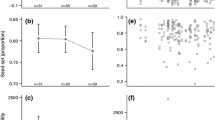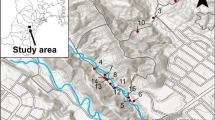Summary
Genetic neighborhood size and area were estimated from pollinator movements over 3 years in a scarab beetle-pollinated clonal herb, Dieffenbachia longispatha (Araceae) at the La Selva Biological Station, Costa Rica. This species was characterized by low densities of reproductive individuals and asynchronous flowering within the population. The pollinator flight distributions were characterized by relatively long mean distances between consecutive visits to inflorescences (83 m) and movements to the nearest neighboring inflorescence in the appropriate phase of flowering. Pollinator movement distributions between consecutive visits to inflorescences were significantly leptokurtic in 2 of the 3 years. I calculated neighborhood sizes incorporating the levels of kurtosis and found minimal estimates of N e to be 227–611 ramets and neighborhood area to be 88 000–180 000 m2. The three beetle species that made 94% of the visits (Cyclocephala gravis, C. amblyopsis, and Erioscelis columbica) varied in their flight distributions and in their contributions to the estimates of neighborhood size. Cyclocephala amblyopsis exhibited the greatest degree of kurtosis in its movement patterns, and neighborhood size based on its movement was large relative to N e calculated from movement distributions of the other two beetle species. Long-distance movements of C. amblyopsis (>300 m) accounted for 68% of the neighborhood size.
Similar content being viewed by others
References
Antlfinger AE (1982) Genetic neighborhood structure of the salt marsh composite, Borrichia frutescens. J Heredity 73:128–132
Antonovics J (1968) Evolution in closely adjacent plant populations. VI. Manifold effects of gene flow. Heredity 32:507–524
Beattie AJ, Culver DC (1979) Neighborhood size in Viola. Evolution 33:1226–1229
Bos M, Harmens H, Vrieling K (1986) Gene flow in Plantago I. Gene flow and neighbourhood size in P. lanceolata. Heredity 56:43–54
Ellstrand NC, Marshall DL (1985) Interpopulational gene flow by pollen in wild radish, Raphanus sativus. Am Nat 126:606–616
Ennos RA, Clegg MT (1982) Effect of population substructuring on estimates of outcrossing rate in plant populations. Heredity 48:283–292
Frankie GW, Opler PA, Bawa KS (1976) Foraging behavior of solitary bees: implications for outcrossing of a neotropical forest tree species. J Ecol 64:1049–1057
Gillespie JH (1975) The role of migration in the genetic structure of populations in temporally and spatially varying environments. I. Conditions for polymorphism. Am Nat 109:127–135
Harding J, Tucker CL (1969) Quantitative studies on mating systems. III. Methods for the estimation of male gametophytic selective values and differential outcrossing rates. Evolution 23:85–95
Levin DA (1981) Dispersal versus gene flow in plants. Ann Mo Bot Garden 68:233–253
Levin DA, Kerster HW (1968) Local gene dispersal in Phlox. Evolution 22:130–139
Levin DA, Kerster HW (1974) Gene flow in seed plants. Evol Biol 7:139–220
Linhart YB (1973) Ecological and behavioral determinants of pollen dispersal in hummingbird pollinated Heliconia. Am Nat 107:511–523
Murawski DA, Gilbert LE (1986) Pollen flow in Psiguria warscewiczii: a comparison of Heliconius butterflies and hummingbirds. Oecologia (Berlin) 68:161–167
Rohlf FJ, Schnell GD (1971) An investigation of the isolation by distance model. Am Nat 105:295–324
SAS Institute Inc (1985) SAS User's Guide, Version 5 Edition. Cary, NC: SAS Institute Inc
Schaal BA (1974) Isolation by distance in Liatris cylindracea. Nature 252:703
Schaal BA (1975) Population structure and local differentiation in Liatris cyclindracea. Am Nat 109:511–528
Schaal BA (1980) Measurement of gene flow in Lupinus texensis. Nature 284:450–451
Schmitt J (1980) Pollinator foraging behavior and gene dispersal in Senecio (Compositae). Evolution 34:934–943
Schoen DJ, Clegg MT (1985) The influence of flower color on outcrossing rate and male reproductive success in Ipomoea purpurea. Evolution 39:1242–1249
Slatkin M (1985) Gene flow in natural populations. Ann Rev Ecol Syst 16:393–430
Smyth CA, Hamrick JL (1987) Realized gene flow via pollen in artificial populations of musk thistle, Carduus nutans L. Evolution 41:613–619
Sokal R, Rohlf FJ (1981) Biometry, W.H. Freeman and Co. San Francisco, p 859
Tonsor SJ (1985) Leptokurtotic pollen flow, non-leptokurtic gene-flow in a wind-pollinated herb, Plantago lanceolata L. Oecologia (Berlin) 67:442–446
Turner ME, Stephens JC, Anderson WW (1982) Homozygosity and patch structure in plant populations as a result of nearest-neighbor pollination. Proc Natl Acad Sci 79:203–207
Waser NM (1982) A comparison of distances flown by different visitors to flowers of the same species. Oecologia (Berlin) 55:251–257
Webb CJ, Bawa KS (1983) Pollen dispersal by hummingbirds and butterflies: a comparative study of lowland tropical plants. Evolution 37:1258–1270
Wright S (1943) Isolation by distance. Genetics 28:114–138
Wright S (1946) Isolation by distance under diverse systems of mating. Genetics 31:39–59
Wright S (1969) Evolution and the Genetics of Populations, volume 2. The Theory of Gene Frequencies. University of Chicago Press, Chicago, p 511
Wright S (1977) Evolution and the Genetics of Populations, volume 3. Experimental Results and Evolutionary Deductions. University of Chicago Press, Chicago, p 613
Young HJ (1986) Beetle pollination of Dieffenbachia longispatha (Araceae). Am J Bot 73:931–944
Young HJ (1988) Differential importance of beetle species pollinating Dieffenbachia longispatha (Araceae). Ecology (in press)
Zimmerman M (1982) The effect of nectar production on neighborhood size. Oecologia (Berlin) 52:104–108
Author information
Authors and Affiliations
Rights and permissions
About this article
Cite this article
Young, H.J. Neighborhood size in a beetle pollinated tropical aroid: effects of low density and asynchronous flowering. Oecologia 76, 461–466 (1988). https://doi.org/10.1007/BF00377043
Received:
Issue Date:
DOI: https://doi.org/10.1007/BF00377043




